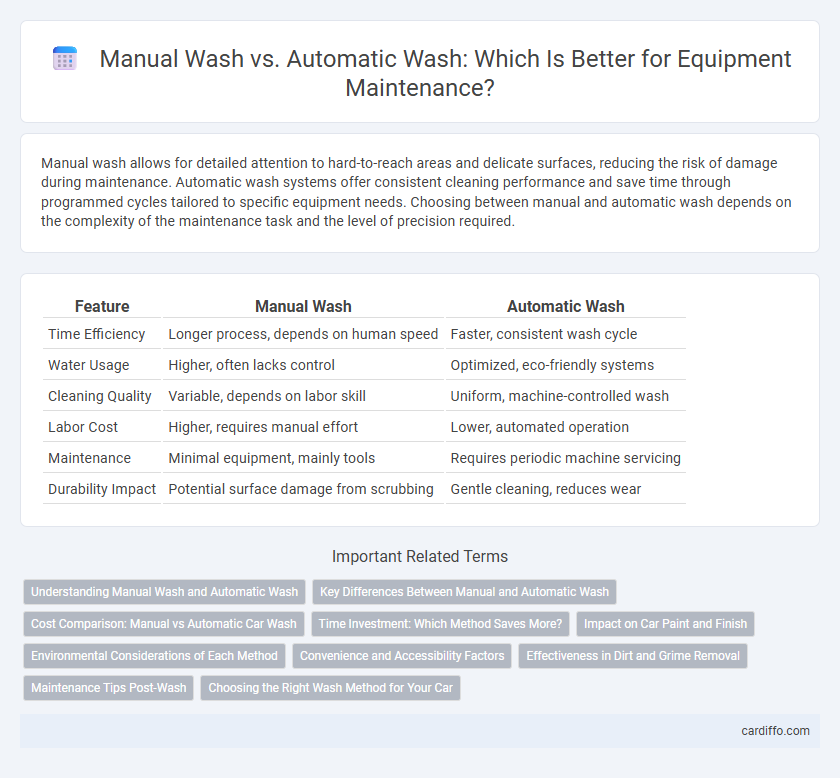Manual wash allows for detailed attention to hard-to-reach areas and delicate surfaces, reducing the risk of damage during maintenance. Automatic wash systems offer consistent cleaning performance and save time through programmed cycles tailored to specific equipment needs. Choosing between manual and automatic wash depends on the complexity of the maintenance task and the level of precision required.
Table of Comparison
| Feature | Manual Wash | Automatic Wash |
|---|---|---|
| Time Efficiency | Longer process, depends on human speed | Faster, consistent wash cycle |
| Water Usage | Higher, often lacks control | Optimized, eco-friendly systems |
| Cleaning Quality | Variable, depends on labor skill | Uniform, machine-controlled wash |
| Labor Cost | Higher, requires manual effort | Lower, automated operation |
| Maintenance | Minimal equipment, mainly tools | Requires periodic machine servicing |
| Durability Impact | Potential surface damage from scrubbing | Gentle cleaning, reduces wear |
Understanding Manual Wash and Automatic Wash
Manual wash involves physically scrubbing surfaces using brushes, sponges, and cleaning agents, offering precision and control ideal for intricate or delicate components. Automatic wash relies on machines equipped with jets, rollers, or conveyors to clean large volumes efficiently, reducing labor and time while ensuring consistent results. Understanding the differences between manual and automatic wash helps optimize maintenance strategies for various equipment types, balancing thoroughness and productivity.
Key Differences Between Manual and Automatic Wash
Manual wash offers precise control over cleaning intensity and is ideal for delicate surfaces, whereas automatic wash systems provide consistent, efficient cleaning suited for larger volumes and routine maintenance. Manual washing consumes more labor and time, while automatic machines reduce human effort and improve productivity with programmable cycles. Water usage also differs, with automatic systems typically utilizing less water due to optimized spray patterns and recycling capabilities.
Cost Comparison: Manual vs Automatic Car Wash
Manual car washes typically incur higher labor costs due to the time and workforce required, whereas automatic car washes reduce labor expenses by utilizing automated machinery. Initial investment and maintenance costs for automatic systems can be significant but tend to balance out over time with increased throughput and efficiency. Cost-effectiveness depends on factors like vehicle volume, water usage, and detergent consumption, with automatic washes generally offering better scalability for high-demand environments.
Time Investment: Which Method Saves More?
Manual wash of vehicles typically requires 30-45 minutes, depending heavily on the level of detail and surface area, while automatic wash systems complete the process within 5-10 minutes. Investment in time for manual washing increases with the quality of cleaning and drying practices, whereas automatic washes provide consistent results with minimal time expenditure. For busy schedules, automatic wash options save significant time, enabling routine maintenance with less disruption.
Impact on Car Paint and Finish
Manual wash offers greater control over pressure and cleaning agents, reducing the risk of scratches and swirl marks on car paint and finish. Automatic wash systems, especially those with abrasive brushes, can cause micro-abrasions and accelerate paint degradation over time. Using touchless automatic washes or high-quality microfiber towels during manual wash preserves the vehicle's clear coat and overall appearance more effectively.
Environmental Considerations of Each Method
Manual washing typically consumes less water per load compared to automatic washers, but inefficient techniques can lead to excessive water use and detergent runoff, impacting local waterways. Automatic washers with high-efficiency settings optimize water and energy consumption, reducing environmental impact by minimizing runoff and electricity usage. Selecting eco-friendly detergents and maintaining equipment enhances sustainability regardless of the washing method employed.
Convenience and Accessibility Factors
Manual wash offers unparalleled convenience for locations without access to advanced equipment, allowing users to clean vehicles or machinery with minimal setup and lower initial costs. Automatic wash systems provide increased accessibility through standardized service times, consistent cleaning quality, and reduced physical effort, making them ideal for high-traffic or commercial settings. Comparing convenience and accessibility, manual washes excel in portability and cost-effectiveness, while automatic washes lead in speed, efficiency, and ease of user operation.
Effectiveness in Dirt and Grime Removal
Manual wash allows targeted scrubbing and spot cleaning, offering superior control over stubborn dirt and grime in hard-to-reach areas. Automatic wash systems provide consistent pressure and detergent application, efficiently removing general surface dirt but may miss deeply embedded contaminants. Combining both methods can enhance overall cleanliness by leveraging the precision of manual cleaning and the thoroughness of automated cycles.
Maintenance Tips Post-Wash
Manual wash requires thorough rinsing to remove all detergent residues that can cause corrosion, while automatic wash systems benefit from regular filter cleaning to maintain water pressure and prevent clogging. Post-wash, drying surfaces promptly with a soft cloth minimizes water spots and rust formation on both manual and automatic cleaning tools. Inspect hoses and nozzles frequently for wear or damage to ensure optimal performance and extend the lifespan of washing equipment.
Choosing the Right Wash Method for Your Car
Selecting the optimal car wash method depends on vehicle type, dirt level, and finish sensitivity. Manual wash offers thorough cleaning with gentle care, ideal for delicate paint and intricate areas, while automatic wash provides efficiency and convenience for routine maintenance. Assessing your car's specific needs ensures preservation of the paintwork and long-term cleanliness.
Manual Wash vs Automatic Wash Infographic

 cardiffo.com
cardiffo.com